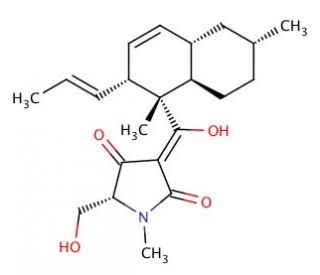

Epiequisetin (CAS 255377-45-8)
QUICK LINKS
Epiequisetin, cataloged under the CAS number 255377-45-8, is a fungal-derived secondary metabolite known for its intriguing chemical structure and biological activity. This compound is a stereoisomer of epiquisetin, featuring slight but significant variations in its molecular configuration, which contribute to its distinct biochemical properties. Epiequisetin primarily functions by interfering with the biosynthesis of essential fungal components, particularly targeting the enzymes involved in the ergosterol synthesis pathway. Ergosterol is crucial for maintaining the structural integrity and fluidity of fungal cell membranes. By inhibiting the enzymes that catalyze the synthesis of ergosterol, epiequisetin disrupts the cell membrane′s function, leading to impaired cellular processes and growth inhibition in fungi. This specific action makes epiequisetin an important tool in mycological research, offering insights into fungal metabolism and the potential mechanisms through which fungi adapt to environmental stressors. Researchers utilize epiequisetin to explore the intricacies of fungal physiology and to identify targets within the ergosterol pathway that could be exploited to control fungal growth in various environmental and industrial contexts. Such studies are vital for advancing our understanding of fungal biology and for developing new methods to manage fungi in ecosystems and agricultural settings.
Epiequisetin (CAS 255377-45-8) References
- A Marine Antibiotic Kills Multidrug-Resistant Bacteria without Detectable High-Level Resistance. | Chen, S., et al. 2021. ACS Infect Dis. 7: 884-893. PMID: 33653026
- Co-Occurrence of Regulated and Emerging Mycotoxins in Corn Silage: Relationships with Fermentation Quality and Bacterial Communities. | Gallo, A., et al. 2021. Toxins (Basel). 13: PMID: 33806727
- Isolation, Screening, and Active Metabolites Identification of Anti-Vibrio Fungal Strains Derived From the Beibu Gulf Coral. | Huang, B., et al. 2022. Front Microbiol. 13: 930981. PMID: 35722281
- Analysis of regulating activities of 5'-epiequisetin on proliferation, apoptosis, and migration of prostate cancer cells in vitro and in vivo. | Wang, X., et al. 2022. Front Pharmacol. 13: 920554. PMID: 36034825
- Antimicrobial and antibiofilm activity of fungal metabolites on methicillin-resistant Staphylococcus aureus (ATCC 43300) mediated by SarA and AgrA. | Martínez-Rodríguez, OP., et al. 2023. Biofouling. 39: 830-837. PMID: 37929585
- Phytotoxicity of equisetin and epi-equisetin isolated from Fusarium equiseti and F. pallidoroseum. | Wheeler, et al. 1999. Mycological research. 103.8: 967-973.
- Development of a scar markerfor the molecular identification of the fungus Fusarium semitectum. | Dal Prà and M., et al. 2008. JOURNAL OF PLANT PATHOLOGY. 90: 63-63.
Ordering Information
| Product Name | Catalog # | UNIT | Price | Qty | FAVORITES | |
Epiequisetin, 1 mg | sc-391529 | 1 mg | $315.00 |
